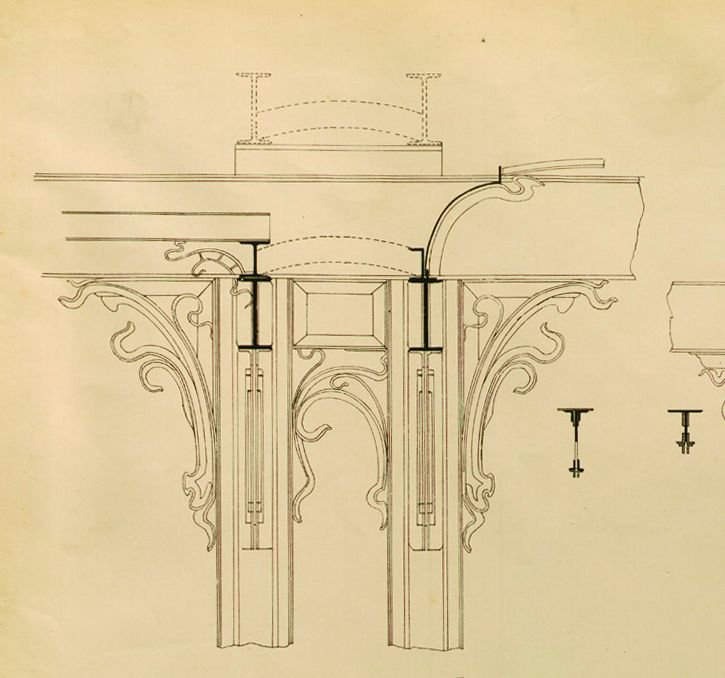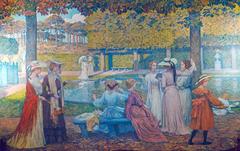
Hôtel Solvay: Visiting Hours, Tickets, and the Essential Guide to Brussels’ Art Nouveau Jewel
Date: 14/06/2025
Introduction
Situated on the iconic Avenue Louise in Brussels, Hôtel Solvay stands as a paragon of Art Nouveau architecture and design. Commissioned by Armand Solvay and crafted by the legendary architect Victor Horta between 1894 and 1903, this residence is celebrated for its pioneering use of steel and glass, opulent materials, and a holistic approach where architecture and decorative arts merge seamlessly. Recognized as a UNESCO World Heritage Site, Hôtel Solvay offers an unparalleled journey into early 20th-century innovation, and its meticulous restoration ensures that visitors today can experience its authentic splendor (Victor Horta; UNESCO; artnouveau.club; Belga News Agency).
This guide delivers all essential information for planning your visit: from Hôtel Solvay visiting hours and tickets, to restoration highlights, accessibility, nearby attractions, and expert tips—ensuring a memorable encounter with Brussels’ architectural heritage.
Table of Contents
- Introduction
- Origins and Historical Context
- Architectural Innovation and Design Features
- Artistic Collaboration and Decorative Arts
- Restoration and Conservation
- Visitor Information: Hours, Tickets, and Accessibility
- Practical Tips and Nearby Attractions
- Frequently Asked Questions (FAQ)
- Summary and Conclusion
- References
Origins and Historical Context
Hôtel Solvay was commissioned by Armand Solvay, the affluent son of industrialist Ernest Solvay. Located in the upscale Ixelles district, the mansion was intended as both a private residence and a showcase of technological and artistic progress at the dawn of the 20th century. Victor Horta was granted an unlimited budget—a rare privilege—allowing him to experiment freely with form, material, and spatial planning (Wikipedia; World of Interiors).
Construction began in 1895 and was completed in 1903. The house immediately became a reference point in Art Nouveau architecture, later joined on UNESCO’s World Heritage List by Horta’s Hôtel Tassel, Hôtel van Eetvelde, and his own home, now the Horta Museum (UNESCO).
Architectural Innovation and Design Features
Structural Pioneering
Horta’s innovative use of steel and glass was revolutionary in residential architecture. The steel skeleton enabled larger, open interior spaces, expansive bow windows, and the introduction of stained glass domes that fill the home with natural light (Visit Brussels; artnouveau.club).
Materials and Motifs
Inside, the mansion dazzles with a palette of over 20 types of marble and 17 varieties of exotic wood, including rare species from the Belgian Congo. Decorative ironwork, original furniture, and flowing, organic lines create a sense of harmony and luxury throughout (Victor Horta; banad.brussels).
Gesamtkunstwerk: A Total Artwork
Horta supervised every element, from the structure to the smallest fixtures, embodying the concept of “Gesamtkunstwerk” or total work of art. The result is a unified aesthetic where architecture, furniture, carpets, lighting, and even the doorbell were custom-designed (Wikipedia; SpottingHistory).
Artistic Collaboration and Decorative Arts
Belgian pointillist Théo van Rysselberghe contributed to the decoration of the grand staircase. Lighting is a key feature, with over 160 custom-designed lamps on the main floor—remarkable for the era (World of Interiors).
The mansion’s stained glass, floral ironwork, and sculptural light fixtures reinforce its organic, nature-inspired Art Nouveau character (banad.brussels).
Restoration and Conservation
Historical Preservation
The 1950s saw potential demolition averted when the Wittamer family acquired the building, preserving it as a private residence and later a haute couture studio. In 1977, Hôtel Solvay was declared a protected monument and joined the UNESCO World Heritage list in 2000 (UNESCO; We Love Brussels).
Recent Restoration (2022–2024)
A major restoration campaign, led by architect Barbara Van der Wee and Ney Partners, addressed structural shifts, corrosion, and facade damage. This €1.5 million project included:
- Stabilizing and cleaning the stone facade
- Restoring all decorative ironwork and metal elements
- Preserving original woodwork and stained glass
- Repairing the roof and waterproofing (Belga News Agency; Ney Partners)
Minimal intervention and historical accuracy were prioritized, earning recognition from Europa Nostra for exemplary heritage conservation (europanostra.org).
Visitor Information: Hours, Tickets, and Accessibility
Visiting Hours
- Regular tours: By appointment only, generally available on Wednesdays and Saturdays.
- Tour duration: Each guided tour lasts approximately 30 minutes.
- Age restriction: Visitors must be 12+ years old to protect the interiors (hotelsolvay.be).
Tickets
- Booking: All tickets must be purchased in advance via the official website.
- Price: Standard admission is €16 per person.
- Combination tickets: Joint tickets with the Horta Museum and Hôtel Hannon are being developed (WeLoveBrussels).
Accessibility
- Mobility: Due to preservation needs, the site is not fully wheelchair accessible. Contact staff for possible assistance.
- Public transport: Easily reached by tram lines 81 and 97, or bus lines 38 and 60.
- Parking: Limited street parking; public transit is recommended.
Guided Tours & Languages
- All visits are guided, in groups of up to 25.
- Tours are offered in French and Dutch; English tours are less frequent, so check language availability when booking (World Heritage Site).
Visitor Guidelines
- Photography: Prohibited indoors to protect the interiors and privacy.
- Dress: Wear comfortable shoes and use provided shoe covers to preserve flooring.
Practical Tips and Nearby Attractions
- Advance Booking: Demand is high; reserve well ahead, especially during Art Nouveau events or festivals.
- Art Nouveau Pass: Consider the Art Nouveau Pass for discounted access to multiple sites (Visit Brussels).
- Location: 224 Avenue Louise, Brussels.
- Nearby Attractions: Horta Museum, Hôtel Hannon, Hôtel Tassel, and Parc Tenbosch are all within easy reach and enrich your Art Nouveau itinerary.
- Neighborhood: The area is vibrant, with shops, restaurants, and embassies—ideal for combining cultural and culinary experiences.
Frequently Asked Questions (FAQ)
Q: Do I need to purchase tickets in advance?
A: Yes, all tickets must be reserved online before your visit (hotelsolvay.be).
Q: What are the visiting hours?
A: Tours are typically available Wednesdays and Saturdays; always check the official website for current dates and times.
Q: Is the site accessible to visitors with disabilities?
A: Accessibility is limited due to the historic structure. Contact the venue for assistance.
Q: Can I take photos inside?
A: No, indoor photography is not allowed to protect the interiors.
Q: Are tours offered in English?
A: French and Dutch are the main languages; English tours are occasionally scheduled—confirm when booking.
Q: Are combined tickets available?
A: Yes, discounted joint tickets with other Horta sites are planned.
Summary and Conclusion
Hôtel Solvay is not only an architectural triumph by Victor Horta but also a living artifact of Brussels’ Art Nouveau heritage. Its meticulous conservation, celebrated with heritage awards, ensures both public access and the safeguarding of its unique interiors. By planning ahead, respecting visitor guidelines, and exploring nearby landmarks, you can fully immerse yourself in one of Europe’s most significant historical sites.
For current information on Hôtel Solvay visiting hours, tickets, restoration news, and exclusive content, visit the official website, follow their social channels, and consider using the Audiala app for guided tours. Embark on your journey through Brussels’ Art Nouveau wonders—Hôtel Solvay awaits.
All information is current as of June 14, 2025.




































































































































